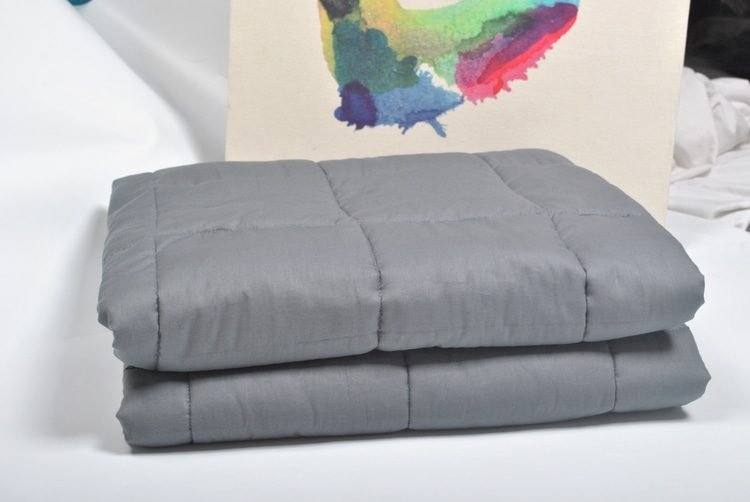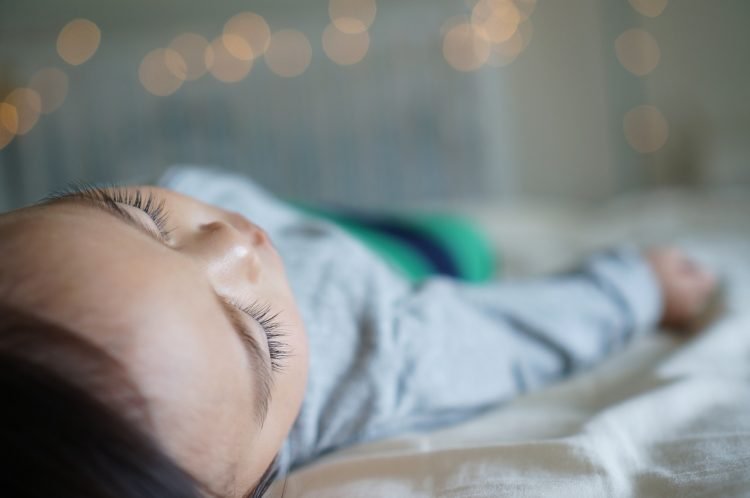A night terror is a sleep disorder in which the sufferer experiences a feeling of dread or intense fear while sleeping. It has been confused, severally, with nightmares.
But they don’t mean the same thing. While a nightmare is just a bad dream, night terrors are more intense feelings of terror in which the person affected can talk, scream, move, thrash about after being roused up from sleep, suddenly.
Weighted blankets are the result of extensive research into the sensory factors that affect sleep and relaxation. They can help people who experience night terrors achieve a healthy and full night of sleep.
By stimulating the Deep Pressure Touch (DPT) zones, weighted blankets stimulate the release of Serotonin which is then converted to Melatonin (the hormone that makes us drowsy and subsequently makes us fall asleep) at night.
Night terrors usually occur during the late stages of Non-Rapid Eye Movement (NREM) sleep. NREM sleep is one of the two alternating phases of sleep.
The other phase is Rapid Eye Movement (REM) sleep and is the part of the period in which dreams and nightmares happen.
What then happens in NREM sleep?
The American Academy of Sleep Medicine (AASM) has broken NREM sleep into three stages.
- In the first stage, the sleeping experiences slow eye movement and what is known as thoughtful sleep.
- In the second stage, there is no eye movement.
- The third stage involves what is commonly known as ‘deep sleep.’
Research has shown that night terror usually occurs in the third stage – while the affected person should be experiencing deep sleep.
This reduction in the amount of time spent in deep sleep has a huge impact on the energy and enthusiasm the person puts into his daily activities as the body still feels fatigued and unrested from the night.
Effect on adults
While other adults wake up refreshed, it is not the same for those who suffer from this sleep disorder. Adults that experience this condition may feel exhausted throughout the day and this could have a profound effect on their productivity and relationships with co-workers.
Effects on children
Children that experience night terrors might be withdrawn from social activities with other children, and pay less attention during school. It’s also common to find them dozing off during school periods as their bodies try to compensate for lost sleep.
Research into the sensory input of weighted blankets has also shown that a weighted blanket can also reduce the level of cortisol released at night.
Cortisol is the body’s stress hormone and its release increases close to waking up every morning.

By inducing the levels of serotonin and cortisol in the body, a weighted blanket can both deepen and prolong sleep.
What Causes Night Terrors?
Although there have been numerous studies on night terrors, it is still not clear as to what exactly the sleep disorder. However, several patterns have been noticed:
Genetics
People with relatives who experience night terrors are more likely to experience them as well.
Other health conditions
Night terrors have also been linked with fever and health conditions such as nocturnal asthma, depression and anxiety, and Restless Leg syndrome (RLS).
Behavioral factors
They could also occur as a result of repetitive behavior such as sleep deprivation, and in the case of adults, alcohol use.
As we have seen earlier, a weighted blanket by providing sensory input stimulates the secretion of serotonin and cortisol. This could help to reduce or eliminate the condition and to achieve proper sleep every night.
Weighted blankets have been shown to achieve this result irrespective of how often night terror ‘episodes’ have been occurring.
Night Terrors: Who can be affected?
Night terrors occur most prominently in young children, although young adults can be affected too. Some studies show that 1-6% of children in the U.S experience night terrors, other studies put their estimate at 15%.
Children that experience night terrors do so between the ages of 4 and 12. In adolescence, night terrors usually almost disappear completely. Boys are also more likely to experience night terrors than girls.
Only a tiny fraction of adults (about 1%) of adults experience night terrors. In adults, night terrors surface in their early twenties or thirties. Among adults, men have been seen to be just as likely to have symptoms as women. Night terrors among adults usually point to mental disorders.
Whether the person affected by night terrors is an adult or a child could affect the choice of weighted blanket, alongside other factors that we will look at below.
Identifying a night terror
The symptoms observed in children and adults experiencing night terrors are usually described from the observation of their parents, friends or partners as most times, people who suffer from the sleep disorder cannot recollect the occurrence and at best just remember seeing frightening images.
Some of the common symptoms observed during occurrences of night terror include screaming, shouting, panting, staring wide-eyed with pupils dilated, sweating, fast heartbeats, kicking and thrashing.
The kicking and trashing could, in fact, be so intense that they could cause bodily injuries to the person experiencing the night terrors and whoever shares a bed with them.
The frequency of occurrence of night terrors varies from one individual to the next. For some, there is a space of days or weeks between each new occurrence while for others its more frequent and could happen on a daily basis.
How do you tell night terrors apart from nightmares?
For a nightmare, the person who has them often wakes up and can narrate the occurrences in the nightmare almost as if it was a movie.
On the other hand, people who experience night terrors can, very rarely, recollect the frightening image they saw. The images people see vary based on their cultural backgrounds. Some see spiders, shadows or snakes.

Also, nightmares usually happen close to the time of waking while night terrors happen farther behind.
Medical diagnosis
Physical Examination: The medical practitioner tries to ascertain the root causes of the night terrors.
Parent/Partner/Patient Interview: A questionnaire is administered to a person that lives with the sufferer. This is done because the patients might be unaware of their sleep behaviors and how it affects other people around them.
Nocturnal Sleep Study: Sensors are attached to the patient and used to monitor brain activity, heart rate, breathing, and movement. A video is also taken of the sufferer at night to confirm the symptoms.
Can night terrors be treated?
Definitely! Night terror ‘episodes’ can be managed or treated by any of the following ways:
Lifestyle Modifications
A good start to overcoming night terrors is lifestyle modifications to possible causes of night terrors.
For adults, these may include going to bed earlier, reducing alcohol intake and reducing the amount of stress during the day (this may translate to reducing work hours).
For children, it includes parents taking an active role in reducing the amount of play time allowed during the day and ensuring that the kids go to bed early every day.
In cases where a lot of thrashing about and subsequent injuries happen during night terrors, a rearrangement of the room to ensure a reduced possibility of injuries during a night terror. However, even with these modifications, night terrors reduce by only a small degree.
Monitored Sleep
This is another method that has been explored in the management of night terrors. In this method, parents (in the case of children) and partners or friends (for adults) take note of the time night terrors usually happen.
Then they could try to pre-empt it by waking the child or adult up fifteen minutes earlier, allowing them to stay awake for a while and then letting them fall asleep again.
This method has seen a great deal of success but among patients has been shown to be unsatisfactory as they reduce the quality of sleep.
However, not everyone wants to be woken up every night in the middle of the night. It could be a challenge for the parents/friends whom themselves have to take a break from sleep. Also, after being woken from sleep, some people find it difficult to find sleep again.
Use of medication
Some parents and spouses are on the lookout for a definite cure for night terrors. This does not exist as is the case with several other sleep disorders. There are a few drugs that can be used to manage the condition and they have to be taken daily for a long period of time.
For children, doctors usually suggest that no drug treatment is used. In adults, doctors prescribe benzodiazepines such as Valium, Ativan, and Xanax or tricyclic antidepressants such as Elavil and Tofranil.
However, these drugs and other drugs that act on the brain are very dangerous when used over a long period of time. Some of the side effects of these classes of drugs include decreased libido, the emergence of nightmares, and, rarely, liver disease.
Side effects of prolonged medication
A very common side-effect of the drugs is drowsiness during the day. This prevents people from working with heavy machinery or driving cars as they could easily fall asleep in the process.
Severe effects from long-term use of these medications include amnesia and a change in personality toward a violent or aggressive personality type.
The body may also get used to these drugs, in what is called tolerance, therefore leading to increased doses of them to get the same effects.
The body might also become so dependent on them that when drug use is discontinued, it leads to other adverse effects e.g. severe insomnia.
Physical therapy using weighted blankets
Physical therapy with weighted blankets drastically reduces the frequency of night terrors in both adult and child sufferers.
Physical therapy can also be used with other non-medication methods such as lifestyle modifications and monitored sleep. However, with daily use of weighted blankets, the need for other methods might reduce and even become unnecessary ultimately.
Negative effects of night terrors
Sleep is meant to be a refresher for the body. However, in people who experience night terrors, a lot of energy is further expended at night.
This leads to other symptoms such as sluggishness, drowsiness, and tiredness during the day. This could lead to a drop in productivity at school (for kids) and at work (for adults).
Psychosocial implications
Relationships with friends (for kids) and with partners (for adults) can also suffer significantly. In fact, a lot of spouses of adults suffering from night terrors can be read on online forums, seeking solutions and complaining about the toll it is taking on their relationships.

This, if taking place for a long period of time and often involving thrashing and violent movement could cause consistent injuries on the spouse and even lead to marital problems.
While a breakdown in the relationship between a child and his or her parents is unlikely to happen because of night terrors, it is heart-breaking as a parent to watch one’s child in such fear and discomfort.
One almost wants to hug the child all through the night, to give that reassuring warmth and comfort. And this is probably an extra reason weighted blankets are so effective in children and adults alike; the feeling of a prolonged soothing hug.
Some sufferers from the sleep disorder also complain about embarrassment the mornings after they have episodes, especially when they sleep over at the homes of their friends or partners.
This sense of shame can lead to withdrawal from people they were formerly friends with and refusal to sleep outside their own homes. They are also extra careful not to take quick naps at the workplace because of the embarrassment they’d feel if a night terror came early.
It is not pleasant to live with this disorder but luckily, there are several options to choose from in management.
How weighted blankets help to manage night terrors
To understand how weighted blankets can help, let’s take a look at how they work in practice. Weighted blankets are based on Deep Pressure Touch (DPT) therapy. Weighted blankets are much heavier than everyday blankets and weigh down on the user gently.
They give the same feeling as a hug or a gentle squeeze, activates the deep pressure touch zones, and leads to the release of endorphins and serotonin with a simultaneous decrease in cortisol.
As we have seen earlier, serotonin is responsible for the production of melatonin, a hormone that helps us fall asleep. By increasing the production of both, they allow the sufferer to enjoy deep sleep throughout the night.
This is further aided by the decrease in the cortisol secretion. Cortisol is the human stress hormone and is responsible for waking early. By reducing its secretion, weighted blankets allow for longer, undisturbed sleep!
By providing a weight on the child or adult suffering from the disorder, it prevents them from excessive thrashing about that could lead to injury.
This is one reason many Occupational Therapists (OTs) are very keen on using weighted blankets as the way out of night terrors related injuries. Changing the arrangement of dangerous objects in the room is merely a half-measure in comparison.
By aiding the release of endorphins, weighted blankets also help for stress and pain relief. This is especially important for people whose night terrors are as a result of stress and tiredness from the day’s work.
Selecting the right weighted blanket for night terrors
Several factors come into play when choosing a weighted blanket. The two most important factors are the weight and size of the blanket.
Weight
The first and most important factor is the weight. It is advised that the weighted blanket should be about 10% of the sufferer’s ideal body weight.
Your ideal body weight is a calculated optimal weight based on your sex, age, height, and fitness level. There are several online tools available for the calculation of ideal body weight.
Size
The ideal weighted blanket must be able to swaddle the child or adult suffering from night terrors completely while both sitting and while lying prone.
A child, except in exceptional cases, would be suited to the 38 inches x 50 inches for a small-sized blanket. Adults have a choice of 38″ x 60″ for medium-sized and 42″ x 72″ large-sized blankets.
However, choices are not limited to these and custom-made blankets can be requested of manufacturers.
Other factors include the choice of material (which can be influenced by weather conditions) and for children, the patterns imprinted on them.
Last words
Night terrors can reduce the quality of sleep of sufferers, decline their productivity and also affect the relationships negatively. In children, it could be a great source of concern to parents and caregivers.
A weighted blanket will provide the right amount of pressure to calm people experiencing night terrors, while also immobilizing them to protect them from injuries as a result of violent motion.
It could be a safer and more effective option than some of the other methods we looked into.

